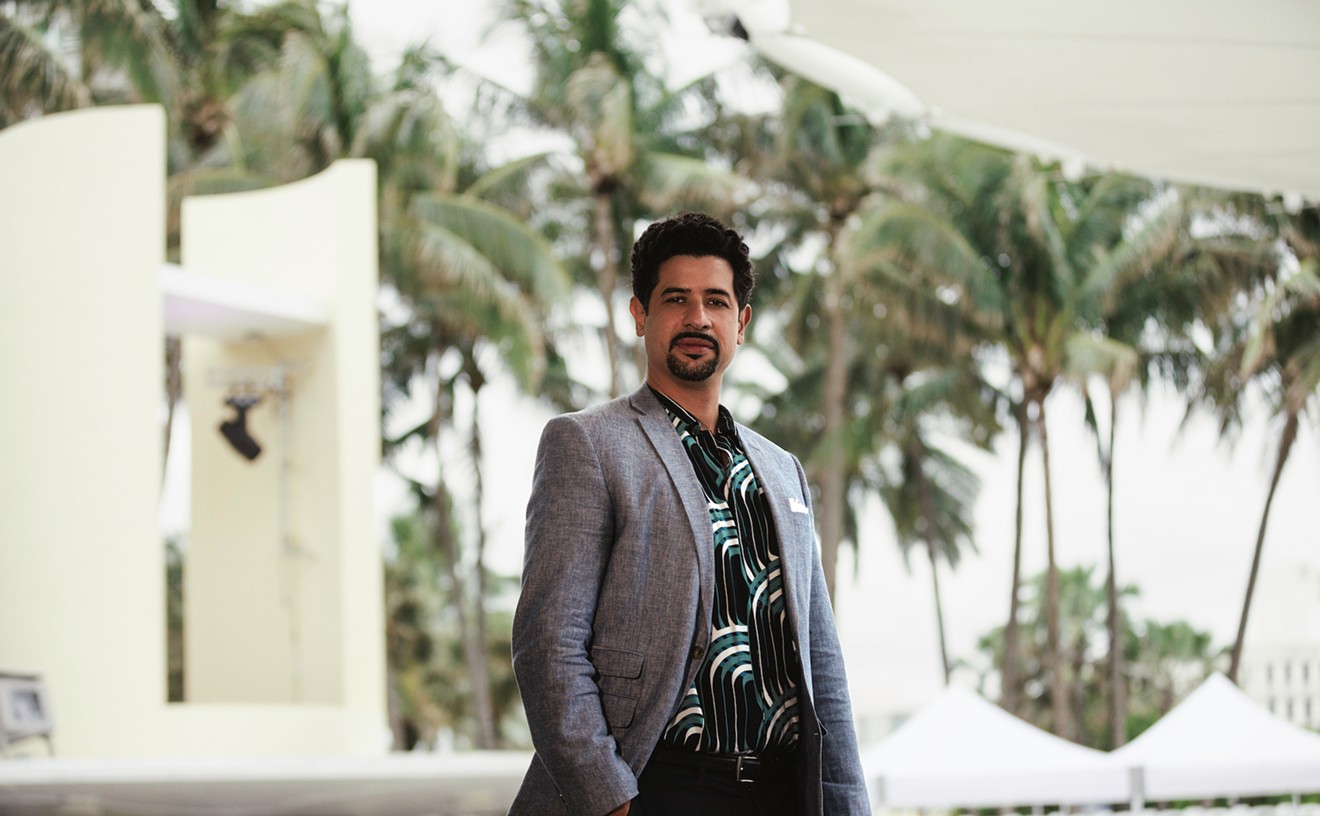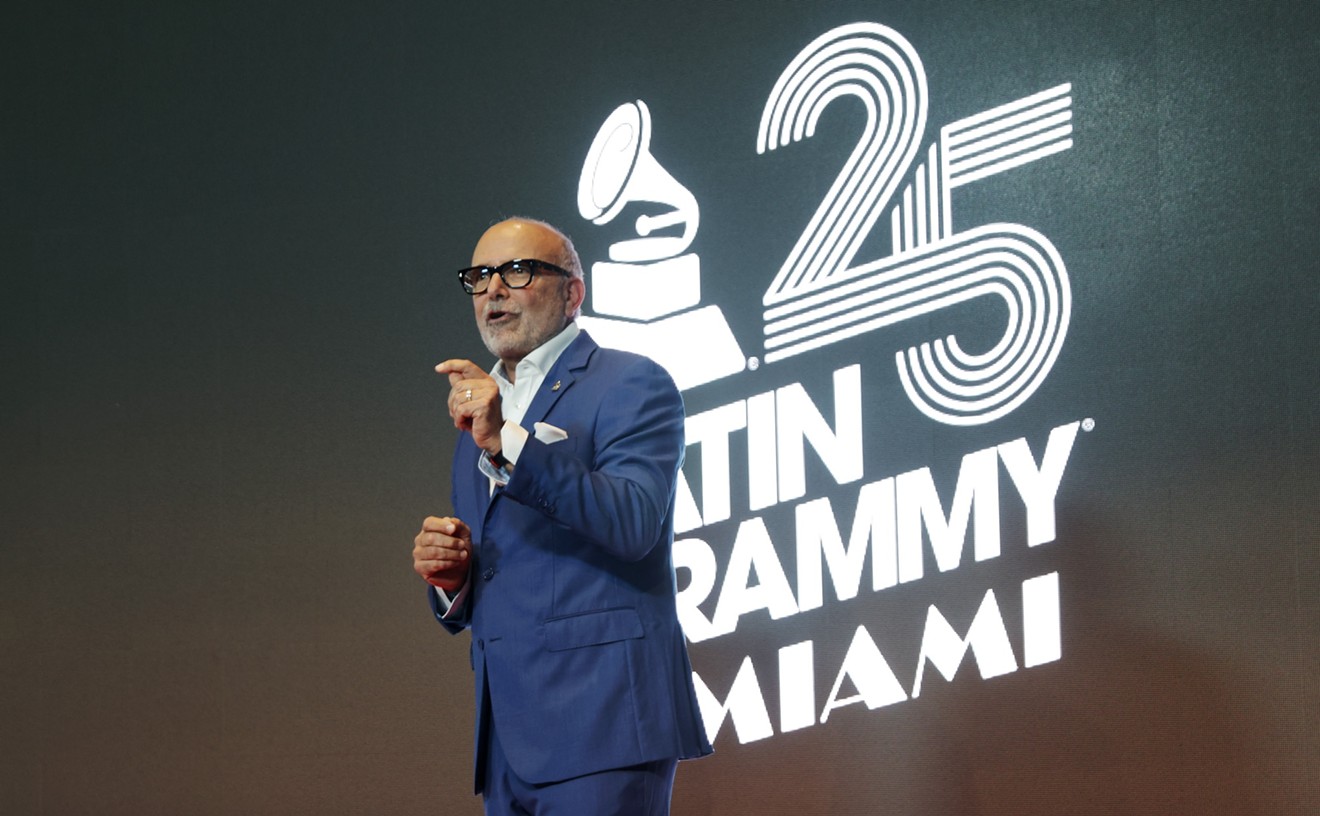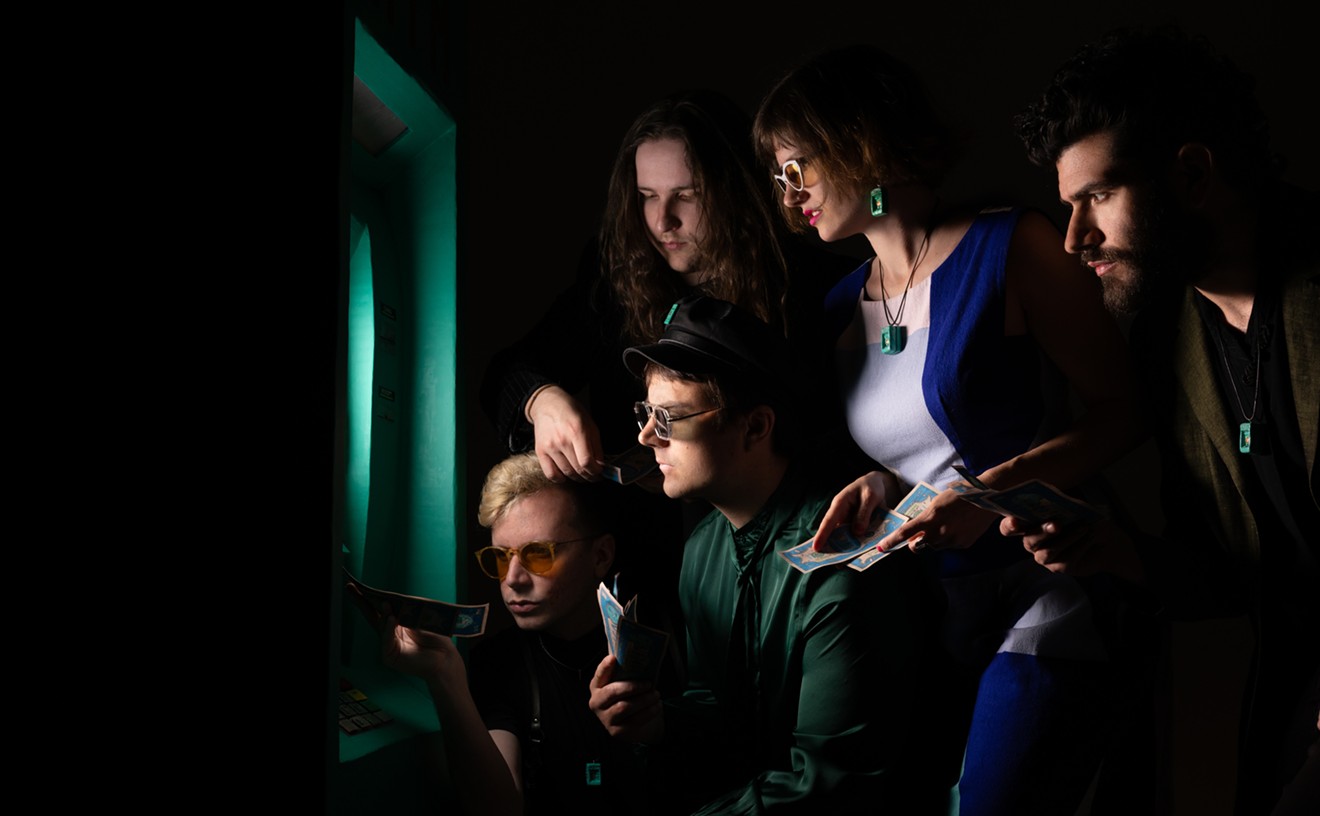A phone rings during a scene in Montage of Heck, animated to one of many audio recordings that Kurt Cobain made during his life, while he was writing the song "Been A Son." Cobain doesn't turn the tape recorder off when he answers the phone, a call for his girlfriend, and viewers witness him take a message before hanging up and returning to work. It's the kind of normal-person stuff that's usually forgotten about celebrities whose faces are on t-shirts at the mall 20 years after they die.
Filmmaker Brett Morgen's documentary about Cobain, Montage of Heck, premieres this Friday at Miami Dade College's Miami International Film Festival 2015, one of several festival premieres in the run-up to its theatrical release overseas and American premiere on HBO on May 4.
See also: Five Signs You Might Be a Shitty Guitarist
The two-hour movie tells the story of Cobain's life from birth to death, using mostly his own audio and video recordings, as well as journal entries and interview clips. Though it is interspersed with interviews Morgen conducted with Cobain's parents, sister, girlfriend Tracy Marander, and Nirvana bassist Krist Novoselic, who was his best friend going back to high school, most of the story is told by Cobain himself, using parts of tapes that he made throughout his life.
"People are going to walk in thinking they're going to get a rock and roll documentary," Morgen says, "but they're going to get so much more."
Courtney Love asked the director to work on this film in 2007, which is when he began going through a deep archive of Cobain's work. What he discovered was a heartbreaking story of a brilliant artist who wanted to work and, above all else, to recreate the family life that he didn't get after his parents' divorce and the rocky childhood that followed.
Rather than focus on Nirvana, or much of Cobain's public persona, what viewers get is a look at the man as a person, rather than as a person through his art.
"The Kurt Cobain in Montage of Heck, whatever we knew before, when people worshiped him, what do we do now?" Morgan wonders, adding that "we weren't trying to put him on a pedestal and we weren't trying to tear him down. We were trying to look him in the eye."
New Times: Courtney Love came to you and asked you to make this movie?
Brett Morgen: The film I'm most known for is The Kid Stays in the Picture. [Morgen's biopic about Hollywood legend Robert Evans.] Courtney was a big fan of that. She told me she'd watched it daily for three months in 2006 or 2007, and what she liked about the film and why she came to me is because it was was considered kind of groundbreaking at the time. It was the first film to use digital animation and After Effects in a feature-length film. It's super-immersive. It wasn't supposed to be about Robert Evans, but it was supposed to personify Robert Evans. I think she liked that approach, and knowing there was this great wealth of art, she felt I could visualize that and bring Kurt to life.
And this movie takes a different angle than almost any movie about Kurt. Generally, documentaries about Kurt focus on Nirvana, but Montage of Heck is literally, singularly about Kurt Cobain's life, from beginning to end. That's most significantly because you got access to all his stuff, right?
Kurt's mother and sister have all of his materials up to about age 14 or 15. Courtney and Frances have most of his stuff from the time he left his home. What I didn't know when I started was that there was going to be five hours of pristine Super 8 film from about six months old to eight years old of Kurt's childhood, in which you could essentially see, with your own eyes, a lot of elements of the Cobain mythology, because Kurt's childhood has a very strong presence in all of his work. But when you see the footage, it tells a slightly different story than what has been presented to us, both by Kurt and by others. That was an incredible revelation that this footage exists, and it's just stunning. There were those elements that challenged the existing myths and were kind of a gift to me as a filmmaker. There was all this material housed in a storage facility in California that had pretty much been sitting there. I think Charlie Cross might have had access to it when he did his book, but nobody else. I was given the keys by Courtney and, sort of, carte blanche. She didn't ask for anything. She never asked for a script. She didn't see the movie. She saw the film for the first time at The Laboratory as I was printing the film two days before the premiere at Sundance.
What was her reaction to it?
She saw the film that night and then she came and sat with us at Sundance. A week later, we were at the Berlin Film Festival and I asked her, as we were heading to the premiere, if she intended to stay for the movie. A lot of actors will show up at a premiere, walk the carpet, and then leave before it starts because they've seen the movie. She goes, "No, I want to see it." I said, "Really? You just saw it twice." And she said back to me, "It's as close as I've gotten to Kurt in the 20 years since he's passed and I want to go spend a couple hours with him." Courtney hadn't seen any of the footage of her with Kurt. Most of that stuff was shot by a friend. She'd never seen it and neither had the friend. The friend contacted me and said, "I have this tape, it might have them on it," and it was all that candid footage from the apartment in L.A. Courtney had never seen that. It was a very intense experience.
You've mentioned the sound of the film in all your interviews. We're talking about a significantly loud rock 'n' roll band here, so it makes sense, but why are you so focused on that aspect of the movie?
I don't know if I could ever get it perfect but it's kind of like a disease. A lot of filmmakers have this. There's something in our minds that's supposed to sound and look a certain way, but you can't achieve it ,because every room looks and sounds different. It's this constant frustration, particularly with sound in this movie. Kurt was an aural artist, as much as a visual artist. Everyone knows about the music, but he experimented with sound collage and spoken word far more than people were aware prior to the film.
Those collages in the movie make it clear that he was trying out a lot of different stuff.
Yeah. The other thing with sound too is one of the challenges of this film was to present the world through Kurt's eyes. I sometimes explain the film as an interior journey through Kurt's life and that was a challenge to externalize. Through journals and artwork, I can get part of the way there, but we needed the sounds to really immerse the viewer. They're the sound of his music and sound collage, as well as the sound design, that capture some of the chaos and angst that swirled around him. In most movies, both fiction and non-fiction, we spend a tremendous amount of time trying to get things to sound like what you're seeing on screen. But in this film, it's all sound. The color and sound in this film, they're like weapons. They're the principle tools in our kits as filmmakers, especially when the film is heavily rooted in acquired material. We had to make the images feel as alive as possible.
You didn't want a film filled with talking heads, something you've talked about throughout your career with all of your documentaries.
Oh yeah. I don't like talking heads as a general rule because there's nothing that immersive or cinematic about watching lips flap. I often feel that if you separate the voice from the visual, you can double down on your information, so you're hearing one thing and you're seeing this other thing. Either they're compatible or the combination of the two can create a new meaning. So this film, when I went into it, I went in with the idea that it was all Kurt. That it would be Kurt's art telling the story of his life. When I needed to contextualize it, I'd draw on interviews with Kurt. And when we got these interviews with Kurt, I believe we got just about everything in existence, I felt that he was, of all the media that he excelled or expressed himself with, interviews just weren't one that he was all that comfortable with. He would either be deceptive, sullen, disinterested or disengaged, and sometimes disingenuous. As I started to hear that stuff, I realized that I didn't want to put that emphasis on his interviews and that I didn't want him to be pedestrian, to have to say, "And then I did this." I also felt that Kurt lacked a certain degree of introspection. While he could articulate himself through his art, he was challenged to tell you why. I felt we needed to step outside for a couple moments, here and there. I realized I needed to have some help in painting this portrait of Kurt and that I'd limit it to those people who would be at Kurt's funeral, whether he was a rock star or the school janitor. These were the five people who were the most intimate with Kurt throughout his lifetime. What works quite well is that his mother, father, and his sister have never participated in on-camera interviews. In the case of the mother and father, they've only done one interview, ever, separately. Nobody had ever seen or heard from the three people who knew Kurt best in life. That to me was a fitting sort of tribute. I think it happened because of Frances and people wanting to get involved because of her involvement in the film.
It seemed like, since you had all this access, you were able to shed light on him as an artist and also as a person in a totally different way. At what point, when going through all this stuff, did you realize you could do something crazy that hadn't been seen before?
The problem with biopics in general is that people think they have to hit all these seminal beats in a life. You end up with a film at the end where you go, "That was interesting, but what was it about? In a book, you can do that. You don't have to have a through-line of action. They're expansive and you can go in all different directions. In a movie, you've got basically two hours, and if you break down that two hours, it's basically ten pages. You need to find a throughline of action and be very consistent.
In the case of Montage of Heck, I felt that I kind of worked backwards at a certain point by saying, "I can't end this movie without giving the viewer some sense of why Kurt is no longer with us." Then you try to figure out the square of what those problems are. And then you go deeper into the square root. And then you keep going until you end up back at the moment of conception. I stayed very consistent with the idea that this was Kurt's psychological journey through life. There's the one thing that popped out at me more than anything else in all the art that I saw, and interviews, and audio, was that Kurt was acutely sensitive to ridicule and shame. He would write about it in his songs and his journals and discussed it in an audio autobiography that he recorded in 1988 that nobody had ever heard or knew existed. In this story, he talks about his childhood, losing his virginity, the shame of losing his virginity, and there's a moment in the story where he says, "I couldn't handle the ridicule from my classmates, so I went down to the train tracks to kill myself." When I heard that for the 100th time, I couldn't ignore it. "I couldn't handle the ridicule so I decided to kill myself." It was like the last scene in The Usual Suspects when they look at the chalkboard and everything comes together. I felt, in that line, there were clues to understanding Kurt's sensitivity and why he's no longer with us. All artists write or create an autobiography with their art. Our stories are embedded as well as reflected with our creations. He was one of the most prolific artists of my generation. He worked with more media than any person I've ever encountered. Super 8 film, sculpture, painting, writing, journals, music, fiction, sound collage. Kurt left a very elaborate, detailed script, and one that was perfectly suited for a film adaptation.
Kurt Cobain: Montage of Heck.Directed by Brett Morgen. Screening as part of Miami Dade College's Miami International Film Festival 2015. 9:30 p.m. Friday, March 6, at O Cinema Miami Beach, 500 71st St., Miami Beach; 305-571-7790; o-cinema.org. Tickets cost $13 via miamiff-tickets.com.
Follow us on Facebook at Miami New Times Music.










